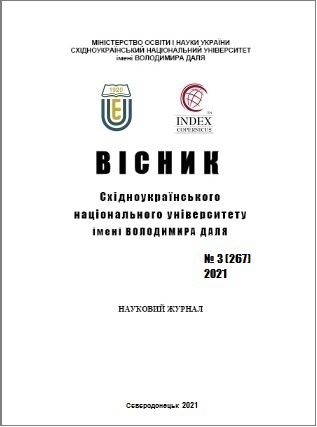Problems of analyzing the achievment of sustainable development goals – state, objects, actors, factors, means, tasks and priorities of changes in the use of resources
DOI:
https://doi.org/10.33216/1998-7927-2021-267-3-13-24Keywords:
goal analysis, adjacency matrix, goal achievement analysis, comparison of indicators, priorities, degrees of significance, levels of development, state research, evaluation of resultsAbstract
The paper speaks of the relevance of analyzing the achievement of sustainable development goals and researching progress towards a safe, fair and sustainable space for the prosperity of all people on the planet is becoming increasingly important in the world. The object of the research is goals that will present different degrees of challenge and ambition for different countries, depending on their current state of development and other national circumstances. Consideration of the problem of non-identity of goal analysis and goal achievement analysis on the example of a well-known set of goals, methods of assessing the significance of sustainable development goals, identifying and processing indicators of their achievement are the subject of the study. In the course of the study, a comparison method was applied using the example of the main macroeconomic indicators of Ukraine and Germany. It has been found that the balance between the social, economic and political efforts required to achieve different goals can be different in different countries. On the example of the global goals of the millennium, declared by the UN, the problem of situational identification of the concepts of "goal analysis" and "goal achievement analysis" due to the similarity of their designation is considered, the interpretation of the proposed non-identity is given. A model of five complex components is proposed as a general basis for the analysis of any groups of elements for describing a problem situation, for formulating goals and objectives for achieving global sustainability. The factors that state the existence of this problem are considered, namely: the presence of certain actors in the form of communities, organizations and the population itself, which have different levels of awareness to understand possible problems associated with the correct interpretation of the above concepts; the existence of a wide range of methods that allow from different sides, using separate points of view, to understand, analyze, investigate the priority, level of progress and the degree of importance of the hypothesis, goals, etc .; the establishment of a certain number of different tasks, contributing to the observance of a certain algorithm of actions aimed at identifying differences, researching each of such non-identities and approving conclusions. It was revealed that different countries will need to pay different degrees of attention and effort to different goals and objectives, depending on where each country ranks in terms of the level of achievement of the goals at a certain point in time, differentiated responsibilities and different capabilities and resources. It is determined that the described problem requires further analysis and research, the identification and application of new methods and ways of the process of simplifying and improving the assessment of achieving goals.
References
1. Галгаш Р. А., Семененко І. М. Цілі та соціальна ефективність некомерційної господарської діяльності. Прометей: Регіональний зб. наук. праць з економіки. Вип. 2. С. 35-39.
2. Забезпечення сталого розвитку регіону: економічні, управлінські, правові та інформаційно-технічні аспекти : колективна монографія / за заг. ред. Ю. І. Клюс., Н. В. Швець. — Сєвєродонецьк: вид-во СНУ ім. В. Даля, 2017. – 282 с.
3. Мировой Атлас Данных Knoema. Германия [Електронний ресурс]. – Режим доступу: https://knoema.ru/atlas/Германия?compareTo=UA
4. Овчаренко Є. І. Система економічної безпеки підприємства формування та цілепокладання. Лисичанськ: ПромЕнерго, 2015. 482 с.
5. Саати Т., Кернс К. Аналитическое планирование. Организация систем. М.: Радио и связь. 1991. 224 с.
6. Саати Т. Принятие решений. Метод анализа иерархий / Пер. с англ. Р. Г. Вачнадзе. М.: Радио и Связь, 1993. 278 с.
7. Скільки сміття залишає Україна та що з ним відбувається – [Електронний ресурс]. – Режим доступу: https://www.slovoidilo.ua/2017/05/29/infografika/suspilstvo/skilky-smittya-zalyshaye-ukrayina-ta-nym-vidbuvayetsya
8. Семененко И. М. Цели деятельности предприятия с позиции социальной ответственности. Вестник Полоцкого государственного университета. Серия D. Экономические и юридические науки. экономика и управление. 2013. №13. С. 62-66.
9. Сталий розвиток: німецький досвід [Електронний ресурс]. – Режим доступу: https://studway.com.ua/sustainable-development/
10. Цілі сталого розвитку – [Електронний ресурс]. – Режим доступу: https://www.un.org/sustainabledevelopment/ru/hunger/
11. Як Україна може подолати сміття – [Електронний ресурс]. – Режим доступу: https://lb.ua/society/2018/04/28/395698_nadiya_ochishchennya_yak_ukraina_mozhe.html
12. Кривуля П. В. Несоблюдение противопостав¬ленности позиций анализа целей и анализа достижения целей в структуре управленческого цикла и вытекающие когнитивные ошибки анализа / П. В. Кривуля // Економіка підприємства: сучасні проблеми теорії та практики: Матеріали дев’ятої міжнар. наук.-практ. конф., 11-12 вересня 2020 р. – Одеса: ОНЕУ; ФОП Бондаренко М. О., 2020. – С. 56-57.
13. Ґендерна рівність– [Електронний ресурс]. – Режим доступу: http://www.un.org.ua/ua/nasha-robota/gender
14. Ґендерні квоти – [Електронний ресурс]. – Режим доступу: https://www.radiosvoboda.org/a/news-genderni-kvoty-u-verhovnii-radi/29970756.html
15. Економічне зростання у 2019 році – [Електронний ресурс]. – Режим доступу: https://hromadske.ua/posts/ekonomichne-zrostannya-u-2019-roci-sklalo-33-poperedni-rozrahunki-uryadu
16. Державна служба статистики України – [Електронний ресурс]. – Режим доступу: http://www.ukrstat.gov.ua/
17. Кобцева Д. А. Впорядкування вирішення завдань та досягнення цілей на базі матриці суміжності (на прикладі цілей сталого розвитку) / Д. А. Кобцева // Майбутній науковець – 2019 : матеріали всеукр. наук.-практ. конф. з міжнар. участю 12 груд. 2019 р., м. Сєвєродонецьк. Ч. ІІ / укладач В. Ю. Тарасов. – Сєвєродонецьк: Східноукр. нац. ун-т ім. В. Даля, 2019. – С. 29-32.
18. Goodreads – [Електронний ресурс]. – Режим доступу: https://www..com/quotes/tag/natural-resources
19. Mary Stacey, Marilyn Taylor, David Legge. A New Role for Natural Resources Companies – [Електронний ресурс]. – Режим доступу: https://www.strategy-business.com/article/00106?gko=6547e
20. National Research Council. 2012. A Framework for K-12 Science Education: Practices, Crosscutting Concepts, and Core Ideas. Washington, DC: The National Academies Press. – [Електронний ресурс]. – Режим доступу: https://doi.org/10.17226/13165.
21. Як врятувати планету від самих себе: гід з економії природних ресурсів – [Електронний ресурс]. – Режим доступу: https://www.the-village.com.ua/village/city/save-the-planet/278075-yves-rocher-special4
22. Новини й аналітика про Німеччину, Україну, Європу та світ [Електронний ресурс]. – Режим доступу: https://www.dw.com.

